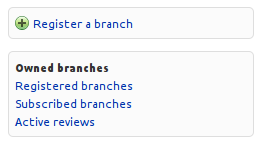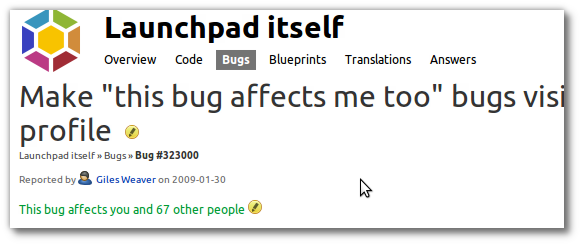Ending support for multi-tenancy
Published by Curtis Hovey November 23, 2011 in Bug Tracking, Code, Coming changes
Launchpad is ending support for multi-tenancy for branches and bugs to ensure that projects can manage the disclosure of private information. This is a fundamental change to how launchpad permits communities to share projects. Very few users will be affected by this change, but several communities will need to change how they work with private bugs and branches.
Launchpad currently permits users to create private bugs or branches that cannot be seen by the project maintainers, or the project’s other communities. This feature permits communities and companies to develop features in secret until they are ready to share their work with the other communities. This exclusivity feature is difficult to use, difficult to maintain, and makes Launchpad slow. This feature also contradicts the project maintainer’s need to be informed and to manage the disclosure of confidential information. When multiple parties can control privacy on a project, important information is lost.
While discussing the proposed changes with Launchpad stakeholders, I was surprised that most believed that the project maintainers could see the private bugs they were reporting — they wanted to collaborate, but the subscription-as-access mechanism is faulty. There are thousands of private bugs reported in Launchpad that cannot be fixed because the person who can fix the issue is not subscribed.
A contributing reason to drop support for private branches on project you do not maintain is that the feature is fundamentally broken. Privacy is inherited from the base branch. If you cannot access the base branch your branch is stacked on, you are locked out. Project owners can, and accidentally do, lock out contributors. You cannot subscribe someone to review the security concerns in your branch if that user does not have access to the base branch. Project contributors must subscribe each other to their respective branches to collaborate on a fix or feature.
This change is a part of a super-feature called Disclosure. To ensure that confidential data is not accidentally disclosed, project maintainers will be able to view and change who has access to confidential project information. Maintainers can add users to security or proprietary policies to grant access to all the information in the respective policy. You will not need to subscribe users to individual bugs or branches, unless you want to grant an exception to a user to access one confidential piece of information.
Launchpad translations service disruption update
Published by Dan Harrop-Griffiths November 22, 2011 in Notifications
Launchpad translations was due to be unavailable from 10.00 UTC for around one hour this morning to allow us to set up translations for the next Ubuntu release, Precise Pangolin (to be 12.04 LTS).
However, by about 10.15 UTC we encountered problems with data already in Precise’s translations. We weren’t sure how long it’d take to fix this issue, so decided it was better to reschedule the translations downtime for another day.
Sorry for the brief interruption to service. We’ll give you at least 24 hours notice before attempting this work again.
Launchpad translations disruption 10.00 UTC 2011-11-22
Published by Matthew Revell November 21, 2011 in Notifications, Translations
Launchpad translations will be unavailable for around one hour, starting 10.00 UTC, on Tuesday 2011-11-22.
During this time Launchpad will not be importing translation files and the web interface for making and reviewing translations will be unavailable. This includes imports for translation uploads, but also imports from Bazaar branches.
We are suspending the service temporarily to allow us to set up translations for the next Ubuntu release, Precise Pangolin (to be 12.04 LTS). Once this is done, imports will resume normally and any backlog should be processed quickly after that.
Ubuntu SSO and Launchpad service disruption 10.30 UTC 17th November 2011
Published by Matthew Revell November 14, 2011 in Notifications
Ubuntu’s single sign-on service will be read-only for around 15 minutes starting at 10.30 UTC on the 17th November. At the same time, Launchpad will be offline.
This means that you should be able to log into websites that depend on the Ubuntu single sign-on service, but not make changes to your login or register a new account. It also means that anything involving Launchpad will be unavailable during that time.
Starts: 10.30 UTC 17th November 2011
Expected back by: 10.45 UTC 17th November 2011
We’re sorry for this service disruption. During this time we’ll be making a database upgrade.
Improved performance for personal code pages
Published by Raphaël Badin November 10, 2011 in Code, General, Performance
Edit 2011-11-15 08:18 UTC: The problem is now fixed and we’ve re-enabled the new menu.
Edit 2011-11-11 13:42 UTC: We’ve temporarily disabled the new menu while we fix some unfortunate side effect.
We’ve just deployed a new, simplified version of the branch menu displayed on the right hand side of personal code pages (e.g. personal page for the Launchpad team). It looks like this:
Calculating the number of branches took way too much time for people/teams with a huge number of branches (e.g. https://code.launchpad.net/~ubuntu-branches), up to the point that they were getting timeouts.
The new design, along with optimisations we’ve made to the database queries, should improve performance for everyone.
Daily builds of huge trees
Published by Martin Pool in Bazaar, Code, Cool new stuff, General
We’ve just upgraded Launchpad’s builder machines to Bazaar 2.4. Most importantly, this means that recipe builds of very large trees will work reliably, such as the daily builds of the Linaro ARM-optimized gcc. (This was bug 746822 in Launchpad).
We are going to do some further rollouts over the next week to improve supportability of recipe builds, support building non-native packages, handle muiltiarch package dependencies, improve the buildd deployment story etc.
Removing a project from a shared bug report
Published by Curtis Hovey November 8, 2011 in API, Bug Tracking, Projects
Launchpad will soon permit you to say your project is not affected by a bug shared with another project — you can delete the spurious bug task. This action can be done from the bug’s web page, and using Launchpad API.
You can remove a project from a bug if you are the project maintainer, bug supervisor, or are the person who added the project to the bug. This action can only be performed when the bug affects more than one project — you cannot delete an entire bug. This feature permits you to undo mistakes.
Launchpad beta testers will see the remove action next to the affected project name in the affects table.
The delete() method was added to the bug_task entry in the Launchpad API. There is a example API script, delete_bugtasks.py, that can remove a project from many bugs. There is also a split action to create a separate bug just for the specified project to track separate conversations in bug comments.
Usage: delete_bugtasks.py [options] bug_id:project_name [bug_id:project_name]
Options:
-h, --help show this help message and exit
-v, --verbose
-q, --quiet
-f, --force Delete or split bug tasks that belong to a public bug
-d, --delete Delete a spurious project bug task from a bug
-s, --split Split a project bug task from an existing bug so that
the issue can be tracked separately
-w WEBSITE, --website=WEBSITE
The URI of Launchpad web site.
Default: https://api.launchpad.net;
Alternates: https://api.staging.launchpad.net,
https://api.qastating.launchpad.net
Previously, you could not remove spurious bug reports about your project. Many were cause by poor bug target management; you could not move a bug between projects and distributions. You can now move bugs between projects and distributions, but thousands of bugs still wrongly claim to affect a project or distribution. This causes clutter on bug pages and searches, and it causes Launchpad performance problems.
This change is a part of a super-feature called Disclosure. To ensure that confidential data is not accidentally disclosed, Launchpad will only permit private bugs to affect a single project. Soon, you may need to remove a project from a bug before marking the bug private.
Launchpad offline 08.30-08.45 UTC 10th November, single sign-on read-only
Published by Matthew Revell in Notifications
Launchpad will be entirely offline and Ubuntu’s single sign-on service will be read-only for around 15 minutes from 08.30 UTC on the 10th November.
Goes offline: 08.30 UTC 2011-11-10
Expected back: 08.45 UTC 2011-11-10
This is to allow us to make a database upgrade. We’re sorry for the disruption that this will cause.
Welcome to BerliOS projects
Published by Matthew Revell October 10, 2011 in General
It’s sad to read that BerliOS will close in December, after nearly twelve years of serving open source projects. One fewer project hosting site means that the open source world is that bit poorer.
If you’ve been hosting your project on the BerliOS Developer platform and you’re looking for a new home, you’ve got plenty of choice.
We’d love to welcome you to Launchpad and here are a few reasons why you should consider Launchpad:
- We can help you import your bug history from BerliOS
- Importing your Subversion repositories is straightforward, too, and something that we’ve done for thousands of repos.
- There’s more to Launchpad than bug tracking and code hosting: code review, support request tracking, blueprint for spec tracking, personal package archives and automated daily builds for getting software to Ubuntu users, translations with a large and active community, plus there’s a web services API.
- You’ll get friendly help in our IRC channel and on our mailing list.
- Bazaar rocks.
- Launchpad itself is open source software.
If you have questions, you’re very welcome to join us in #launchpad on FreeNode and the launchpad-users mailing list.
Finding bugs that affect you
Published by Martin Pool October 4, 2011 in Bug Tracking, Coming changes, Cool new stuff, General
We’ve recently deployed two features that make it easier to find bugs that you’re previously said affect you:
1: On your personal bugs page, there’s now an Affecting bugs that shows all these bugs.
2: On a project, distribution or source package bug listing page, there’s now a “Bugs affecting me” filter on the right (for example, bugs affecting you in the Launchpad product).
Counts of the number of affected users already help developers know which bugs are most urgent to fix, both directly and by feeding into Launchpad’s bug heat heuristic. With these changes, the “affects me” feature will also make it easier for you to keep an eye on these bugs, without having to subscribe to all mail from them.






